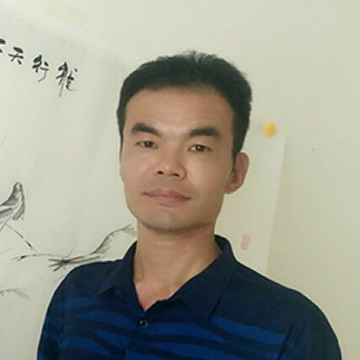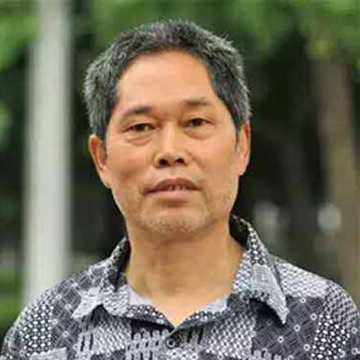1
1997年9月在小兴安岭画风景,山里落叶缤纷,天气变化无常。商英那次穿了一身崭新的羽绒,中黄,十分耀眼。一个月写生回来,这身中黄已经彻底迷彩了——全是泥土、颜料,他画画时完全顾不上干净,太投入了。
商英有股憨厚劲,也有股狠劲。
那次他是画了几幅好画,虽然幅面不大,但是品质好,耐看。色彩在风景写生的时候也应该是有情有境的,必须是被概括出来的,在相互关系中被提炼出来,成为一种有意向的,有倾向有追求的色彩。当时我们同行一路的十来个人都迷着那种色彩关系,每天背着画箱分头走散去画,回来吃饭聚在一起。在林场的小食堂里把画沿着墙根儿排开,一边吃饭一边议论。
那时候商英念念叨叨的一句名言是:“单纯。”
当时他是一而再再而三地说着“单纯”。有时候是一面点着头说“单纯”,带着憧憬;有时则是一面摇着头,一面说“单纯”,几乎是恶狠狠的,仿佛要切断什么。这种决心,这种追求,既是针对色彩,又是针对造型,也是针对油画语言的整体。
从央美的附中到央美的本科再到研究生,商英经历了从爱好到专业之间的转变,用李可染先生的话讲,“打进去”了。克服千难万险千辛万苦,从无法到有法,从利家变成了行家,变成了专业圈子里面一颗引人注目的新星。2
从2004年到2008年,商英集中画了内蒙古家乡风物。2004年画马的《母与子》和2007年画牛的《乌兰察布之歌》,同工异曲,赞美生命。两幅作品一前一后相距短短三年,后者热烈而直接的情绪,与手段的老到、色彩的生猛,笔触的自由奔放、游刃有余,都已经升入了全然不同的新一重境界。这些马,这些牛,这些可爱的生灵,这些可爱的自然的造物。壮硕的公牛跃上去,俨然升起了一座金山,横空出世。喜鹊的“在场”,是商英的神来之笔,悠然,在场而并不在意。
我喜欢那些人物,《守望》、《祖母》、《播种者》、《旁京》、《四叔》、《桂宝》以及《了见了》等等,也喜欢《等待收获》、《北方》、《门》、《阿尔山草原》、《伊尔施镇》、《麦田》、《小站》、《黄昏阿尔山》等等风景。
这些内蒙古的家乡风物,纯净得一尘不染,暴雨洗涤后阳光普照,商英眼中的一草一木和一砖一瓦,眼中的牲灵和人物全都平等,平等地沐浴在大自然永恒的阳光下,生息繁衍。它们都如此平凡,又如此贵重,他们以自己平凡的生命构建了大自然雄浑神奇的历史。3
《太行山系列》和《雪域高原系列》是2009-2011年间的新作。商英在《江孜古堡》、《玛旁雍错》、《雪域高原》、《湖那边》、《夜音》、《圣湖》等作品里揭开了新的一幕,既是瑰丽多彩,又是神奇狰狞。与内蒙古的家乡风物显然不同,这里不再是朝夕与共的家园,而是异域他乡,甚至也许是人迹罕至的神灵出没的地方,烟涛微茫云霓明灭。
如果说商英过去笔下的故乡风物是一篇篇散文,那么《雪域高原系列》则演化成一首首长诗神话。商英用迷离的大笔书写,如梦如幻又如梦如歌,象是与天神对话,象是叩问永恒的谜。
这些是华彩篇章,呼风唤雨,元气淋漓。
我相信这些作品不能出自精确的设计,不能预先安排了制作的程序,而必须是出自直抒胸臆,随兴之所至,一切修养一切推敲、计算和斟酌,全都包含在一气呵成的过程之中。
在方法这个层面之外更重要的是,商英的作品一而再地显示着他不屈不挠的一种追求,对于画面意境的追求。当他已经进入了绘画艺术的行当里面,当他已经熟悉了行当的规则之后,是不是就可以这样停下来,踞守着现成的疆土重复已有的成果呢?商英的天性不是如此。艺术的生命没有终点,题材没有边界,商英把握住前人的成就,同时把目光投向了未来——一切尚未被开垦的未知的荒原、未知的星球,那些“不入画”的地方,曾经被告知的“禁区”。无论如何,规定航线之外的海洋才是神秘诱人的永恒魅力所在,那里有前所未见的新颖的题材,那里有前所未见的人的精神境界,从“有法”升华到更高级的“无法”状态。既要学会沿着航线走,还要勇于探索。4
2008年秋天,商英在悉尼参加一个国际性的素描研讨活动,在会上他宣读了自己的一篇论文,讨论造型“细节”的艺术表现力。他是与会艺术家中很年轻的一个,雄姿英发又很懂事,沉着低调。他发言朴实、内秀,会下大家议论都觉得好。商英确实内秀,内心很丰富,每隔一段时间就必须对他刮目相看,尤其现在的他正处于生长期,蓬勃的生长期。如果从他画的“作爱的牛”回望他画的“母子马”,可以说一脉相承,但是如果从他的“母子马”预估未来,实在是无法预测,正如从他平静无垠的大草原,从他笔下那些平实的阳光雨水,如何去预料他后来梦幻的狰狞?他像一株树苗,上蒙蓝天雨露,下得大地滋养,今天抽得一条枝,明天开得一片花,太阳照红了几只果,风雨又摇落了几片叶,他成长起来了,越来越壮大,越来越丰厚,见到的人会说,这是“一株独立支撑的大树,不是向两旁歪倒的小草。”2012年1月22日Changing's Paintings1
It was September, 1997. Shingling was painting from life in Lesser Khingan Mountains where there were all kinds of colorful leaves and the weather varied greatly during the day. Wearing a new medium yellow down coat, he stood out against the landscape. When he came back a month later, the coat had totally turned into camouflage with mud and pigment all over. He was too absorbed in his drawing to care if his outfit was neat or not.
Shangying himself is quite complex, sometimes simple and good-natured but sometimes very resolute.
That time he finished several paintings. Though not very large, they were beautiful in their own right. In a landscape sketch, colors must fit in with the author's emotion and context, and they must be extracted from relations, therefore becoming something intentional. At that time, we, more than a score in total, were all so obsessed with this sort of color relation that we went on separate ways to draw inspiration from nature and went back together for dinner after a whole day's work. Our paintings were put along the wall in a small dining hall where we could exchange our ideas while having supper.
The most frequent word that Shangying used to emphasize is "simplicity". He kept saying it all the time. Sometimes he nodded murmuring it whereas sometimes shook his head in a hideous tone, as if to cut something off. This determination along with his artistic pursuit is targeted not only at the color and modeling, but also at the pictorial language as a whole.
From a student at the middle school attached to CAFA to a bachelor of CAFA and in the end a graduate there, he has undergone the transition from interest in painting to a profession all the way. In Li Keran's words, Shangying has entirely "got into painting'. After all the trials and tribulations, he has eventually turned himself into a newly-rising star in the circle of artists.2
From 2004 to 2008, Shangying has painted typical scenery in Inner Mongolia, his hometown. Sharing the same theme of love of life, "Mother and Son" in 2004 and "Song of Ulan Qab" in 2007 achieved the same artistic effect. With only three years' difference, the latter about bulls, more passionate and direct than the former about horses, coupled with skillful approaches, bold colors, and free strokes, showed that he had embarked on a new stage in art. How lovely are these horses and bulls! These robust bulls in the painting are like a golden mountain arising out of nowhere. The presence of the magpie is his stroke of inspiration, creating a carefree prospect of presence but not deliberate concern.
I love those characters in his works, such as "The Watchman", "Grandmother", "The Sower", "Pangjing", "Uncle", "Guibao", and "I Saw", as well the scenery in "Waiting for Harvest", "The North", "Door", "The Arxan Prairie", "Yiershi Town", "Wheat Field", "The small Station", "Arxan in the Dusk", etc.
The landscape in his hometown is as pure as snow. After a rainstorm, the sun comes out and sunshine floods the earth. In Shangying's eyes, everything, such as plants, bricks, animals and human beings, are equal, living in the sunshine from generation to generation. So common but still valuable, they create the mysterious history of nature with their own lives.3
"Tai-hang Mountains Series" and "Snow Plateau Series" came out respectively in 2009 -2011. In a series of works, such as "Castle in Jiangzi", "Lake Manasarovar", "Snow Plateau", "Beyond the Lake", "Sound at Night", "The Holy Lake", etc., Shangying has unfolded a world, colorful and magic but ferocious. Unlike the scenery in Inner Mongolia, it is not his familiar homeland but exotic land, even a remote and secluded land where sacred spirits would show up. In this world, things come and go, leaving almost no traces.
If the paintings featuring his hometown are a series of prose, then the "Snow Plateau" is nothing short of an epic. With his wandering strokes, Shangying painted fantasies, in which he has a talk with the spirits of heaven, meditating on the miracle of Mother Nature.
In these paintings, Shangying seems to be able to mix with the vigorous and magnificent nature.
I believe that all of these paintings must come out of true instant feelings not of design or prearranged painting procedure. All his artistic accomplishment, reflections and considerations are condensed in this painting process which ends at one stretch.
Beyond techniques, what matters more in Shangying's paintings is his pursuit for artistic conception. Will he stop and just rest on his laurels since he has got familiar with the rules in the field of painting? Shangying is not made for that. He will never be satisfied with what he has achieved. There is no terminal in art nor is there a boundary in theme. It is also true of Shangying's world of art. Based on the achievements his forerunners have made, Shangying aims high and looks ahead into the future-every unknown wasteland and every planet that is labeled "no entry" to a painter. Anyway the eternal charm lies in the ocean off the sea route, as one can always find some new themes in such a spiritual realm of human spirit. He wishes to step away from the routine and to enter a much higher state of freedom. As an artist, he must learn to go along with the sailing route but also to be brave enough to explore the unknown world ahead.4
At an international seminar on sketch in Sydney in August 2008 Shangying gave a talk about the artistic expressiveness involved in modeling "details". Compared with other participants, he is fairly young and ambitious but calm as well as thoughtful, always keeping a low profile. His speech, simple but thought-provoking, was well accepted by all the participants. Indeed, Shangying is a diamond in the rough. He has a really rich inner world. Every once in a while you will find something new about him and his art, and it is particularly true now, as he is still in a vigorous growing stage. Take "Bulls in Love" for reference, we can see "Baby Horse with Mom" is a continuation, but it is really impossible to make predictions according to "Baby Horse with Mom", just us there is no way to expect fantastic ferocity from the serene boundless prairie and the natural sunshine and rain in his paintings. Like a sapling, he is nourished by the blue sky and the soil. Today there is a new branch and tomorrow we will see blossoms, and fruits will follows days later. With wind and rain, several leaves will fall. This sapling will eventually grow into an independent strong man. "It's an independent tree not a swaying grass," people would say.January 22, 2012
[广告] 作品编号10031635,字画之家保真在售
《春华秋实|带中华国礼章》
张忠伦作品 / 136×68cm / 软片未裱

 车厚宾,清溪苑主,号虾痴,男,汉族。1974年生于……[查看]
车厚宾,清溪苑主,号虾痴,男,汉族。1974年生于……[查看] 陈坚(本名陈光荣),号石上耕夫、瓦砚斋主人,中国当……[查看]
陈坚(本名陈光荣),号石上耕夫、瓦砚斋主人,中国当……[查看]


